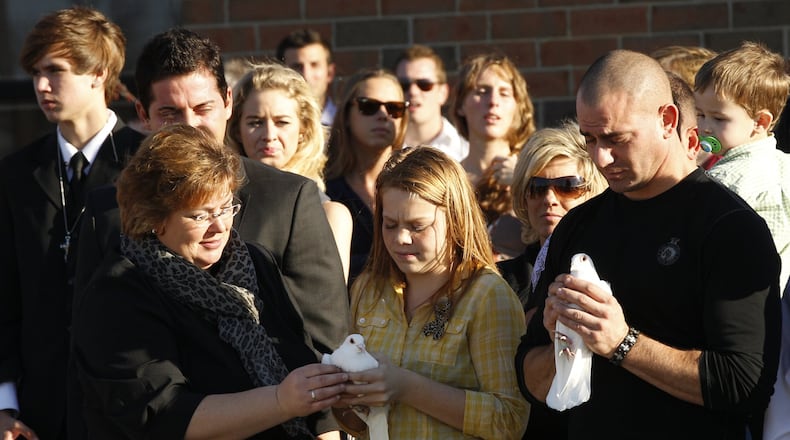It came last October when a Greenon High School junior died after the car he was riding in crashed into a utility pole.
Or last May when a Bishop Fenwick High School student died after being ejected in a rollover crash involving a teen driver.
It comes — everyone can agree — all too often, and as Ohio lawmakers ponder significant changes in the state’s driver’s license laws, young people like Northmont High School junior Emily Frantz can be numbered among the proponents.
“I’m an older sister, so I thought about how it would keep myself, my friends and my sisters safe,” Frantz told lawmakers about the proposed rules. “I would have felt more confident driving if I had been given a year’s worth of practice and instruction.”
Related: ODOT: Several area counties among top 25 for teen crashes
A bill approved by the Ohio House Transportation Committee in an 11-3 vote last week would attempt to do just that. House Bill 293 would extend the temporary instruction permit phase for new drivers to 12 months, up from six months, meaning new drivers would spend time on the road in each of the four seasons.
The bill would also delay issuance of the first license to 16 1/2 years of age and set the curfew for unsupervised teen drivers at 10 p.m., two hours earlier than the current law that requires parental supervision between midnight and 6 a.m.
Advocates for the changes insist that it’s for the safety of the teens — and the rest of the motorists on the roads. Between 2014 and 2016, teen drivers were at-fault in 95,259 crashes statewide, including 286 fatalities and 41,411 injuries, according to the Ohio Highway Patrol. The biggest mistakes: following too closely, failure to yield, unsafe speed and failure to control.
“Not only are those teens and their families impacted but the rest of us on the road are too,” said Anne Goodman, injury prevention coordinator at OhioHealth, a Columbus-based hospital system. “We need to work harder at protecting young teen drivers and all of us who are on the roads with them.”
Related: Where do teen drivers have the highest crash rate in Ohio?
The Insurance Institute for Highway Safety says strong graduated driver licensing programs are an easy win for states.
The institute’s online calculator shows how states could reduce crashes and fatalities if they adopted combinations of stringent rules for teens: limiting unsupervised night- time driving hours, boosting the permit and license ages, increasing practice driving hours and limiting the number of passengers teens are allowed to carry.
Rolling back the state’s night driving restrictions for teens from midnight to 10 p.m., as is the case with this bill, could result in a 5 percent reduction in fatal crashes, the calculator estimates. Moving the license age up to 16 1/2 could result in another 7 percent reduction in fatal crashes.
“A lot of these kids, at six months, hardly have any driving experience in,” said Mendy Ruecking, co-owner of Bee Driving School in Hamilton. “I think it’s going to maybe — hopefully — enhance the skills of the young driver more than what they’re required now.”
The institute reports that Ohio could see a 39 percent drop off in fatal crashes for teens if it embraced the strongest limits, according to the online calculator.
The greatest reduction in fatal crashes — 16 percent in Ohio, the institute estimates — would come from prohibiting teens from driving other teens. Some 15 states and the District of Columbia have enacted such a restriction, according to the institute.
Related: Community remembers three students killed in crash
In 2016, there were 305,964 traffic crashes resulting in more than 112,000 injuries and 1,133 fatalities, according to Ohio State Highway Patrol statistics. Data show drivers under age 26 were involved in 27.3 percent of the accidents and are more likely to be at fault than older drivers.
In 2017, drivers aged 15, 16 and 17 were involved in 20,501 accidents, including 55 fatalities and 5,434 injuries across the state. They were at fault in 68.4 percent of those crashes, the data show.
Of Ohio’s 7.8 million licensed drivers, 96,757 have temporary instruction permits, 63,804 are age 16 and 86,526 are age 17, according to the Bureau of Motor Vehicles.
House Bill 293 is backed by the Ohio Conference of AAA Clubs, Ohio Association of Chiefs of Police, Ohio Fraternal Order of Police, Nationwide Children’s Hospital, Ohio PTA and others.
While Frantz favors a more stringent law, she knows it could some time for her Northmont High School peers and others to adjust.
“I think for the kids who are in the process of getting it now, it would be a big deal for them,” she said. “But eventually it would become the new normal. I think for the first couple of years there would be some grumbling among kids.”

